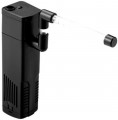Recommended aquarium volume
The volume of the aquarium in liters in which the filter will ensure proper water purification performance. This parameter is usually indicated approximately, because when choosing an aquarium filter, it is important to take into account other factors: the degree of population of the monastery for underwater inhabitants, the size of the fish, etc.
Filter
—
Mechanical. Filters designed to remove solid suspensions from aquarium water, such as leftover food, fish waste, debris, sand, and other small particles. Mechanical filtration ensures water clarity and cleanliness, improving the visual appearance of the aquarium and reducing the concentration of solid particles. Typically, this filtration is performed by sponges with varying pore sizes.
—
Multi-level. Models that provide multiple levels of filtration. Most commonly, multi-level filters perform both mechanical and biological water purification (removing solid particles and breaking down organic matter). Advanced aquarium filters may also include chemical filtration, where water is purified using chemicals and adsorbents like activated carbon.
— Filter volume. This refers to the capacity of the filter's internal chamber, where filtering materials and purification mechanisms are placed. Measured in liters, it indicates how much water the filter can hold during operation. The larger the volume, the more efficient the filtration, allowing for longer intervals between cleaning the aquarium.
— Number of baskets. This refers to the number of baskets that hold different filtering materials. The number can vary from one to three, and occasionally even up to four or five. A larger number of baskets is common in complex filtration systems, which may also include additional water treat
...ment stages such as ultraviolet sterilization, water heating, and more.Power
The power level, measured in watts, determines the energy consumption of the filter and/or its components (compressor, fan, etc.). This parameter indicates how much electricity the filter “winds” during operation and is not directly related to its filtration performance (see below).
Performance
The volume of water that the filter is able to process and purify per unit of time. Often this parameter is measured in liters of water per hour. Filter performance is directly related to the recommended aquarium size. It is customary to ensure that the flow rate of liquid passing through the filter in one hour exceeds the volume of the reservoir at least three times. Thus, for a conventional aquarium with a volume of 200 l, the recommended filtration capacity should be at least 600 l/h.
Water flow adjustment
The ability to select the optimal direction of water flow at the filter's outflow relative to the water surface. Adjusting the flow angle ensures even distribution of oxygen and nutrients, while also creating a suitable water current that mimics the natural habitat conditions for fish. Additionally, by
adjusting the water flow direction, it's possible to prevent debris buildup and the accumulation of waste in specific areas of the aquarium.
Country of brand origin
Country of origin of the brand under which the products are presented on the market. Often indicated by the nationality of the company or the location of its headquarters. However, the actual production capacity of a brand often differs from its country of origin.
Let us note that the quality of products depends not so much on geography, but on the specific organization of processes and quality control at all stages of production. Therefore, national prejudices regarding brands from certain regions, as a rule, are not supported by anything. It is necessary to pay attention to the country of origin of a brand only if the goal is to fundamentally support or bypass a manufacturer from a specific country.

